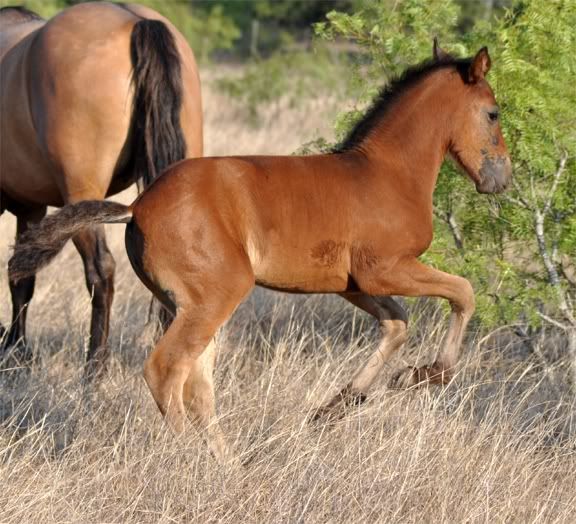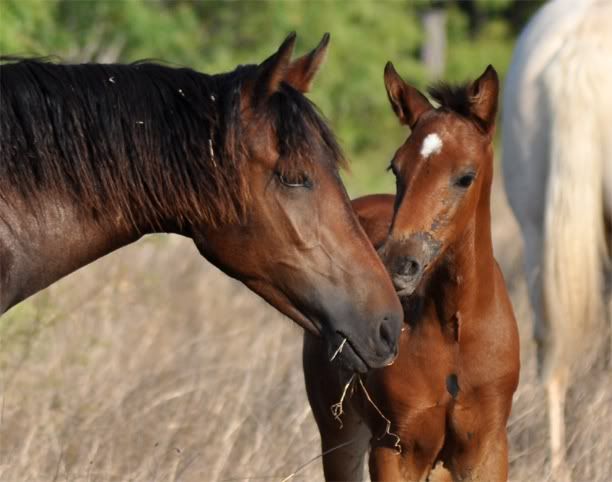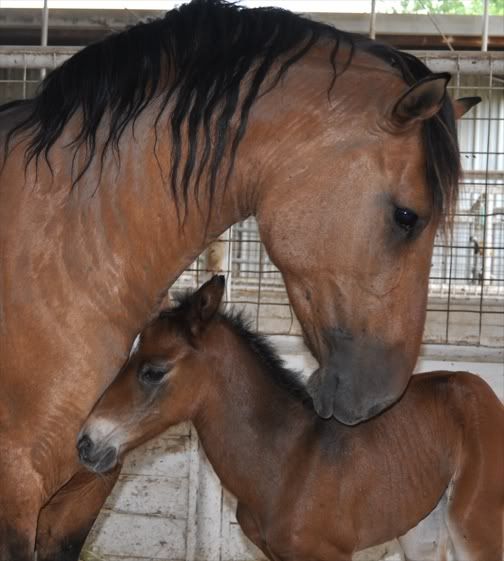|
|
Post by sbutter on Aug 7, 2011 15:43:01 GMT -5
|
|
|
|
Post by Michelle Clarke on Aug 7, 2011 16:50:51 GMT -5
Brown...like our fillies Kahlua and Deja Vous:   Here's one of my favs...Deja Vous giving kisses to her big sis, Kahlua:  I am intrigued with this color coming from the Kigers. I plan to breed these fillies to Gringo but also to some non-dun Lusos and see what comes of it. It would not surprise me if we got some duns. |
|
|
|
Post by sbutter on Aug 8, 2011 10:48:00 GMT -5
He really reminded me of Kahlua with those dark "patches" on the neck. It seems like this color is popping up more often.
|
|
|
|
Post by Michelle Clarke on Aug 8, 2011 10:56:19 GMT -5
Deja Vous had them too when she was born:  |
|
|
|
Post by kimk on Aug 8, 2011 11:43:21 GMT -5
Exactly like my Juneau, but I would call it bay not brown
|
|
grullagirl
Weanling
  Have you hugged your horse today?
Have you hugged your horse today?
Posts: 238
|
Post by grullagirl on Aug 9, 2011 7:33:46 GMT -5
WOW that foal looks identical in color to Kahlua and Deja Vous! Is anybody going to test their kigers for the brown gene? It would be interesting to see how many kigers carry this possible gene.
|
|
|
|
Post by barbhorses on Aug 10, 2011 11:48:31 GMT -5
I always thought Michelle's foal and after looking at the foal in Sweden that they would be called mahogany bays with counter shading. Very intense counter shading really!
|
|
grullagirl
Weanling
  Have you hugged your horse today?
Have you hugged your horse today?
Posts: 238
|
Post by grullagirl on Aug 10, 2011 18:02:00 GMT -5
That would make since in some ways since there are bay duns in the kiger breed. I think the coat differance is just a little bit to different to be classified as a bay. Can the bay and sooty gene combine to produce this color?
|
|
|
|
Post by DianneC on Aug 13, 2011 0:50:18 GMT -5
When combined with the dun gene the sooty gene seems to be all over the body and not along just the top line. The difference in color between brown or brown dun and sooty bay dun is pretty clear. With brown the gene doesn't remove hardly any black so its MUCH darker. Here is Cruiser at 3 days and a yearling at his new home with Gin Reschke (photo by Gin Reschke) and he is sooty dun or bay dun. His dam, LadyRose is dun, his dad, Chinook, is darkest grulla - max sooty. Chinook was tested and does not have the agouti (bay gene) or the brown gene. He is homozygous for black with no creme.   |
|
|
|
Post by barbhorses on Aug 13, 2011 12:33:02 GMT -5
I always thought that horse was a bay! Does he have a crisp and clean dorsal stripe?
Counter shading can often be mistaken to be a dorsal stripe.
|
|
|
|
Post by DianneC on Aug 13, 2011 21:35:47 GMT -5
Cruiser has no countershading over his topline as you can see, and yes he has a clear eel stripe dorsal. Sooty adds back black, with the dun gene it usually adds it all over except for the face. The face is slightly lighter with a mask and dark cheeks. Here is the typical pattern on the face. This is a foal born grulla with stripes and a clear sharp dorsal, not fuzzy edged as in countershading (which is sooty without dun). A black horse is black all over. This is grulla with heavy sooty.  The other filly in this picture is bay. |
|